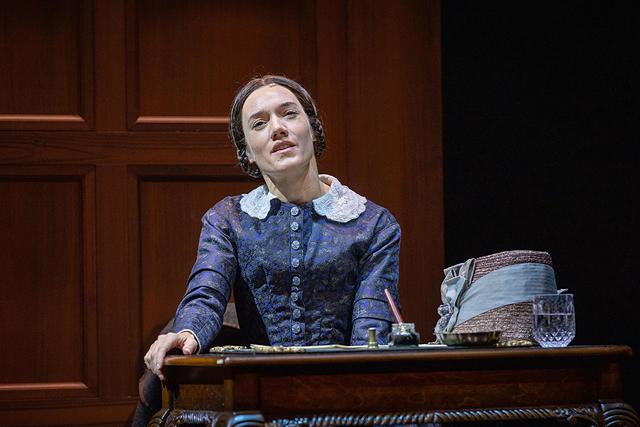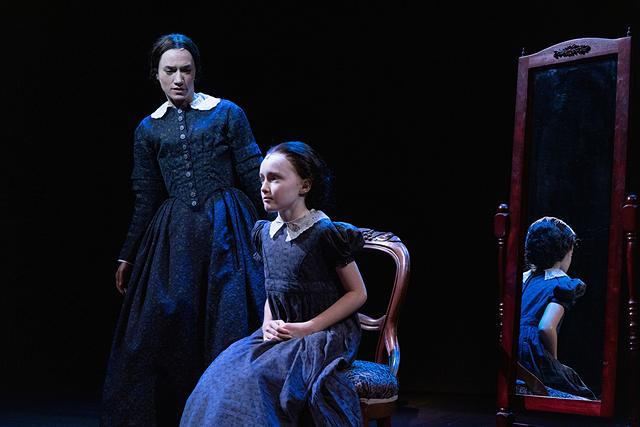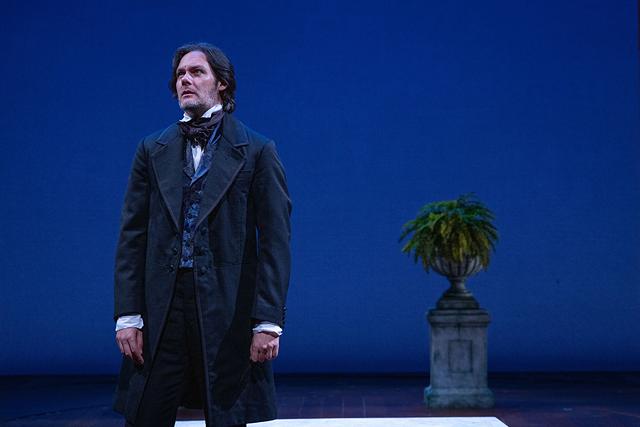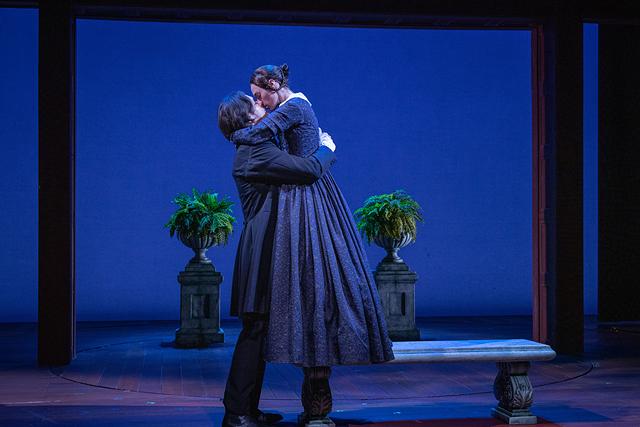
- PHOTO BY RON HEERKENS JR.
- Helen Sadler performs in the title role of "Jane Eyre" at Geva Theatre Center.
The set is sparse, and the play opens with only a spotlight on the desk where Jane writes the story that she dictates directly to the audience. Of course, it’s not her full life story. This production abridges the 600-page novel, chopping out Jane’s childhood and a hundred pages of character development to start when she moves to Thornfield to become a governess under Mr. Rochester’s employment.
Jane addresses the audience with direct quotes so often that at times the play feels like an enhanced audiobook. With the exception of vibrant and puffy period dresses, designed by Ilona Somogyi, much of the world-building and action is left to the audience’s imagination. Sliding panels and a rotating turntable slowly bring out furniture that hints at rooms around Thornfield or the garden outside. Major plot moments—like Rochester falling off a horse when he first sees Jane, or a midnight fire in a bedroom—happen behind a large wooden panel while the audience waits for Jane to narrate what we’ve missed.

- PHOTO BY RON HEERKENS JR.
- Helen Sadler as Jane Eyre and Ella Stone as Young Jane.
Sadler and Beitzel are well supported by an ensemble that plays over a dozen side characters, appearing in short bursts before moving on to the next role. The actors capture each role so convincingly that one needs to check the program to confirm it was Awesta Zarif who plays both the snobby Blanche Ingram and the ominous Grace Poole, or Grayson DeJesus who embodies both righteously angry Mr. Mason and the gently earnest St. John Rivers.
The cast does a fine job of bringing Charlotte Brontë’s characters to life, but doing so only highlights how inappropriate this narrative is in the aftermath of the #MeToo movement. This is certainly not to fault Charlotte Brontë for failing to anticipate the needs and sensibilities of audiences long after her death. However, one should question the decision to launch a theatrical season with outdated depictions of romance and madness.

- PHOTO BY RON HEERKENS JR.
- Robert Beitzel performs as Mr. Rochester.
The show revels in the lush language of Rochester’s courtship to Jane, as well as the novel’s Gothic elements, with offstage manic laughter, fog and candles, and haunting strings. The source of this impending horror? Mr. Rochester’s first wife, the madwoman in the attic. She makes a dramatic appearance in the second act, played with an animalistic ferocity by Felicity Jones Latta. Given a broader cultural understanding of mental health, it’s deeply off-putting to see a mentally ill woman portrayed as an inhuman threat. Once her purpose as a spooky thrill ends, she’s quickly brushed aside while her husband cries in a fetal position about how wretched he is because his plan to travel to colonized Jamaica and marry for money backfired.

- PHOTO BY RON HEERKENS JR.
- Robert Beitzel and Helen Sadler in "Jane Eyre" at Geva Theatre Center.
Geva Theatre Center’s “Jane Eyre” continues through Oct. 2. For more information, go to gevatheatre.org.
Katherine Varga is a freelance writer for CITY. Feedback on this article can be directed to Daniel J. Kushner, CITY's arts editor, at [email protected].
